
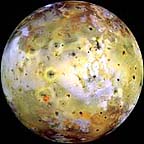 The spectacular planetary body Io is the
innermost moon of Jupiter, and the most volcanically active body
in the solar system. It is the only body outside the earth to
exhibit active volcanism on a massive scale. The first images
to arrive from the Voyager 1 spacecraft as it passed by Io in
1979 astounded the scientific community by revealing active volcanic
plumes rising up to 300 km above Io's surface. As additional images
arrived from the Hubble Space Telescope and the Galileo spacecraft
(1996-2000), we have come to realize that this remarkable body
is dotted by hundreds of volcanic centers, about 70 of which are
active. As shown in the image here, Io's surface is extraordinarily
colorful, with yellows, oranges, reds, and blacks reflecting compositionally
diverse eruptions, from great outpourings of basaltic lava to
massive deposits of sulfur. The lack of impact craters on Io's
surface is consistent with a young period of vigorous volcanism,
which has buried older structures with lava, sulfur, and pyroclastic materials forming the dimpled,
variegated crust we see today.
The spectacular planetary body Io is the
innermost moon of Jupiter, and the most volcanically active body
in the solar system. It is the only body outside the earth to
exhibit active volcanism on a massive scale. The first images
to arrive from the Voyager 1 spacecraft as it passed by Io in
1979 astounded the scientific community by revealing active volcanic
plumes rising up to 300 km above Io's surface. As additional images
arrived from the Hubble Space Telescope and the Galileo spacecraft
(1996-2000), we have come to realize that this remarkable body
is dotted by hundreds of volcanic centers, about 70 of which are
active. As shown in the image here, Io's surface is extraordinarily
colorful, with yellows, oranges, reds, and blacks reflecting compositionally
diverse eruptions, from great outpourings of basaltic lava to
massive deposits of sulfur. The lack of impact craters on Io's
surface is consistent with a young period of vigorous volcanism,
which has buried older structures with lava, sulfur, and pyroclastic materials forming the dimpled,
variegated crust we see today.
The first images obtained from Voyager 1 in 1979 showed a strange umbrella-shaped feature that appeared to be protruding from Io's surface. Soon it was realized that the feature was an eruption plume, largely composed of SO2 gas, rising 260 km above the surface. Additional Voyager images revealed additional volcanic plumes. A total of 15 active plumes have now been identified from the images obtained through the Voyager and Galileo Missions, two of which are shown here:

|

|
|
taken by Voyager spacecraft |
taken by Galileo spacecraft |
Spacraft instruments have provided us with important data on the nature of these explosive eruptions. Voyager's Infra-red Interferometer Spectrometer (IRIS) indicates that most of the active plumes correspond with anomalously hot areas on Io's surface. Data from Galileo's Near-Infrared Mapping Spectormeter (NIMS) appears to suggest that many of these high-temperature explosive eruptions are driven by SO2 gas emission, whereas others appear to be driven by volatilized sulfur emission. In contrast, explosive eruptions on earth are driven largely by H2O and CO2 gas emission.
Unlike the surface of most other planetary bodies, the extensive volcanic activity on Io can generate dramatic changes to it's surface over very short timescales. The colored surface is largely covered by volcanic plains composed of overlapping lava flows and volcanic plume deposits dominated by pyroclastic particles composed largely of condensed SO2 frost, sulfur, and in places, subordinate silicate tephra.
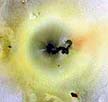 The red deposits on Io
appear to represent young, ephemeral SO2-rich pyroclastic material that will last perhaps
only a few years before turning yellow or bright white. The lighter
colored SO2 frost is probably coarser
grained than the younger, red-colored SO2. The yellow ring in the image to the left
was deposited by the volcanic plume Prometheus which has
been an active site of volcanism for over 20 years. Over this
time, the source of plume has shifted 70 km to the west. Most
scientists believe that the source for this long-lived plume is
from a vent lying at the west end of the dark lava flow in the
image. However, there is some speculation that the plume might
be a product of the advancing lava as it flows over and volatilizes
the SO2-rich surface.
The red deposits on Io
appear to represent young, ephemeral SO2-rich pyroclastic material that will last perhaps
only a few years before turning yellow or bright white. The lighter
colored SO2 frost is probably coarser
grained than the younger, red-colored SO2. The yellow ring in the image to the left
was deposited by the volcanic plume Prometheus which has
been an active site of volcanism for over 20 years. Over this
time, the source of plume has shifted 70 km to the west. Most
scientists believe that the source for this long-lived plume is
from a vent lying at the west end of the dark lava flow in the
image. However, there is some speculation that the plume might
be a product of the advancing lava as it flows over and volatilizes
the SO2-rich surface.
An example of a spectacular ring of red pyroclastic debris comes from the active volcanic plume Pele, shown in the two Galileo images below. These images were taken less than six months apart. Note the dramatic change that has occurred over this time period near the volcano Pillan Petera, marked by the red arrow. The April image shows the simple caldera of Pillan Petra located within the red pyroclastic ring of the Pele plume. However, the September image shows a circular, dark deposit about 400 km in diameter surrounding the caldera. The dark deposit covers an area about as large as the state of Arizona and is most likely composed of silicate-rich pyroclastic material.
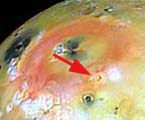
|
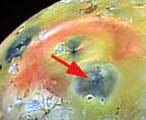
|
|
on April 4, 1997 |
on September 19,1997 |
Lava flows are also rapidly changing the face of Io. A spectacular example of active lava production is demonstrated in the second pair of images shown below. These images, taken three months apart, lie within a chain of giant calderas known as Tvashtar Catena. The November 1999 image on the left displays a fissure eruption (arrow) that appears to be generating a "curtain of fire" which is a typical feature displayed by many Hawaiian-type eruptions on Earth. The fissure shown here is about 40 km long and the "curtain of fire" extruding from it appears to rise about 1.5 kilometers above the surface. The eruption appears to be associated with the generation of active lava flows at the base of the fissure. The second image, to the right, was taken three months later in the February 2000. At this time, the site of volcanism has shifted to the west (arrow) to generate a lava flow that is over 60 km long.
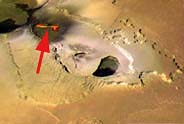
|
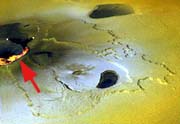
|
|
on Tvashtar Catena (November 25, 1999) |
on Tvashtar Catena (February 22, 2000) |
Lava flows on Io have many of the same characteristics as the low-viscosity basaltic lava flows found on earth, as demonstrated in the images below. The Amirani and Maui lava flows (lefthand image) are the longest active lava flows known to exist in the solar system. The flows travel down lava channels that extend more than 250 km away from a common vent. The white deposits that encircle the vent are probably SO2-rich vapors that were ejected above the surface where they froze as solid particles that settled to the ground as snow or frost.
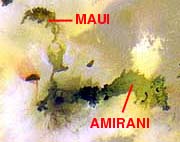
|
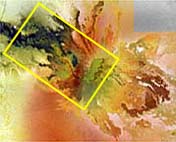
|
|
lava flows (Oct. 8, 1999) |
Culann Patera (May 18, 2000) |
The righthand image (above) displays the lava flowfield of Culann Patera. These flows spill out on all sides of a central caldera. The variegated colors of the flows are most likely related to the interaction of the hot lava with SO2-rich debris on the ground surface as well as SO2-rich ash fall. Some of these silicate lavas might be invasive flows that have been colored by interaction with the overlying sulfur-rich deposits.
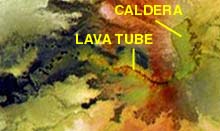
|
The region confined to the yellow box the image above is blown up in the image shown here. The summit caldera of Culann Patera appears to be the source of a lava tube that feeds the large, dark green flow to the west. The axis of the western part of the flow is marked by what appears to skylights lying above the tube's continuation. These features are typical of basalt lavas found on Earth. |
Lava composition is partly a function of the temperature of the melt. Data from Galileo's NIMS instrument indicates that the average temperature of active lavas on Io is about 1600 degrees Centigrade. There has been some speculation that some of the lavas may be composed of liquid sulfur. Sulfur, however, boils vigorously on Io's surface at at about 500 degrees Centigrade. Therefore, the lavas on Io are certainly of a silicate composition. High-temperature lavas on earth have a mafic composition (rich in magnesium and relatively depleted in silica). The extraordinarily high temperatures of the lavas on Io suggest that they are of an ultramafic composition. The eruption of ultramafic lavas on Earth has been rare in the recent geologic past. However, such lavas were common in the early history of the Earth (~2.0 to ~4.5 billion years ago) when the Earth's internal heat content was much greater. These hot, ultramafic lavas are capable of melting other rock types as they travel on planetary surfaces. Thermal erosion by ultramafic lavas are probably responsible for generating the sinuous rilles we see on the moon, and similar featuers may yet be found on Io.